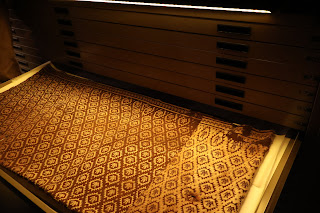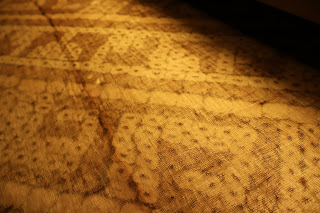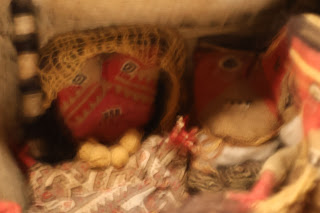The most well-known Chancay artefacts are the textiles which ranged from embroidered pieces, different types of fabrics decorated with paint. A variety of techniques, colours and themes were used in the making of textiles. They used an array of colours including yellows, browns, scarlet, white, blues and greens.
In type of fabric used include llama wool, cotton, chiffon, and feathers. Their technique involved were decorated open weave, brocade, embroidery, and painting. Brushes were used to paint anthropomorphic, zoomorphic, geometric and other creative designs directly on the canvases. The Chancay are known for the quality of their painted tapestries. The typically geometric designs also included drawings of plants, animals such as fish, cats, birds, monkeys and dogs (most notably the hairless Peruvian dog) as well as human figures. Some of the human fiber sculptures are elaborate and include such scenes as a mother teaching her daughter to weave on a backstrap loom. Birds and deities wearing crescent-like headdresses were one of the more common decorative features. They produced a variety of goods such as clothing, bags, and funeral masks.
Many Chancay textiles survive to date. It is believed that their production was quite extensive, due to the quantities that have been preserved. The quality of the textile material appears to be good as they were carefully made.
Fabrics or gauzes were used primarily for religious and magical purposes. They were made for covering the head of the dead in the form of a headdresses. According to the beliefs of the time, the threads on these fabrics had to be spun in the form of an "S" in an anticlockwise direction. This thread, which had a magical character, was called lloque and, according to legend, the garments were infused with supernatural powers and served as protection in the afterlife. Feathers were inserted into a main thread which was then sewn onto the fabric.
The Chancay also manufactured dolls and other objects covered with pieces of woven fabric and various threads.
|
Chancay culture
|
1. Chancay fabrics
|
1.1 Chancay fabric |
|
1.2 Chancay fabric |
|
1.3 Chancay fabric |
|
1.4 Chancay fabric |
|
1.5 Chancay fabric |
|
1.6 Chancay fabric |
2. Simple and complex gauzes
|
Simple and complex gauzes
|
|
2.1 Chancay gauze |
|
2.2 Chancay gauze |
|
2.3 Chancay gauze |
|
2.4 Chancay gauze |
|
2.5 Chancay gauze |
3. The reticulates
|
The reticulates
|
|
3.1 Chancay reticulate |
|
3.2 Chancay reticulate |
|
3.3 Chancay reticulate |
|
3.4 Chancay reticulate |
|
3.5 Chancay reticulate |
|
3.6 Chancay reticulate |
4. Double cloth
|
The double fabrics
|
|
4.1 Chancay double fabric |
|
4.2 Chancay double fabrics |
|
4.3 Chancay double fabrics |
|
4.4 Chancay double fabric |
5. Resist dyeing or shibori
|
Resist dyeing or shibori
|
|
5.1 Chancay resist dyeing fabrics |
|
5.2 Chancay resist dyeing fabric |
|
5.3 Chancay resist dyeing fabric |
|
5.4 Chancay resist dyeing fabric |
6. Painted fabrics
|
Painted fabrics
|
|
6.1 Chancay painted fabric |
|
6.2 Chancay painted fabrics |
|
6.3 Chancay painted fabric |
7. Patchwork
|
7.1 Chancay patchwork |
|
7.2 Chancay patchwork |
Chancay mantle
|
Large Chancay mantle |
Dioramas
|
Diorama with fabric sculptures - Wedding
|
|
Diorama with fabric sculptures - Yunza
|
See also
Source
Location


















































































